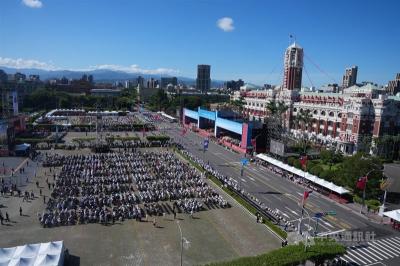Rescue efforts continued yesterday as search teams raced against time looking for thousands of villagers trapped by mudslides caused by Typhoon Morakot.
As of press time, more than 400 victims had been rescued by the military yesterday, but hundreds of villagers were still waiting for help and at least 400 people were unaccounted for.
Kaohsiung County — in particular Jiaxian (甲仙), Liukuei (六龜) and Namasia (那瑪夏) townships — had the highest number of casualties, with dozens of bodies found yesterday and hundreds still missing at press time.
One search and rescue team walked along destroyed and flooded roads to Liukuei Township for several hours to rescue villagers and found 26 bodies lying among fallen rocks.
“Give us body bags. We must get the bodies out first,” Su Ting-kuo (蘇定國), head of the team, said on the cable channel CTi-TV.
Lee Chi-hsiung (李智雄), director of political warfare at the Army Command Headquarters, said a unit of 13 soldiers, who began making their way to Jiaxian Township's Xiaolin Village (小林) on Monday, reached the site of Xiaolin Elementary School before noon yesterday.
Late last night, the Central News Agency reported that around 700 people had been located in the area and that they had been supplied with food and water and that evacuations would start today.
Military forces began rescue work at the crack of dawn yesterday, sending the first helicopter into Xiaolin Village at 6:12am and a second one at 9:13am, along with 73 more Army Special Forces, the Central Disaster Emergency Operation Center said.
Although media and some survivors said they feared hundreds had been buried under the mudslide in Xiaolin Village, the center said that the Army Special Forces had not found signs of people under the rubble by late last night.
Before noon, the army had evacuated scores of victims by helicopter from Xiaolin Village, Namasia's Minzu Village (民族), Jiaxian Township and Taoyuan Township's (桃源) Chinhe Village (勤和), the military said.
At 8:30pm, Taoyuan Township Meishan Village (梅山) suffered another devastating blow when the bank of a barrier lake collapsed, aggravating the flood in the area.
Kaohsiung County issued an emergency evacuation order for residents living near Laonong River (荖濃溪).
Drawing from reports of soldiers who had arrived at the affected villages, the center said the impact of the disaster on the five hardest hit villages had become clearer.
The center said that the military had air-dropped about 1.3 tonnes of supplies to the stranded victims in Xiaolin Village.
About 30 people were trapped atop Hsi-an Mountain (錫安), upstream from Xiaolin Village, the center said.
As the residents said their houses were still intact, they only asked that the military air-drop them food and supplies, the center said.
Further upstream in Namasia Township, about 100 people were trapped in Minzu Village, 100 in Namasia Village, 50 in Minchuan Village and 20 in Minsheng Village, the center said.
Although the military had been evacuating victims via helicopter from Xiaolin — which has the highest number of victims — since morning, clashes broke out between heartbroken and anxious survivors and the army, with several men trying to break through the military lines to get back onto the helicopters.
“I want to go back and find my family,” one man said.
The military later agreed to allow three men to return to their villages to rescue their families.
Four sisters from Liukuei Township's Chonghsing Village (中興) knelt in front of the news camera, pleading for rescue forces to go to their village as soon as possible.
“Our women, disabled people are trapped inside, nobody is there to save them ... We had no electricity, water, food and roads. Please save them, please go in and save them ... If somebody doesn't go in soon, you will have to prepare body bags for them,” one of them said.
After being relocated to Jiaxian's Cishan Junior High School, a Minzu Village survivor surnamed Lin (林) cried and pleaded for help to rescue 26 of her family members, who were still trapped in their village.
“My mother just suffered a stroke recently and has heart disease. I am so afraid that she won't make it,” Lin said.
“We also have children in the house, all of whom are under 15, and some are still in cribs,” she said.
Continuing heavy rain hampered rescue operations in mountainous villages, where hundreds of people were still thought to be stranded. The storm, which triggered the worst flooding in Taiwan in 50 years, dumped as much as 2m of rain before moving on to China.
The Central Weather Bureau (CWB) reported yesterday that Taiwan was still under the influence of air currents from the southwest and could still experience heavy rainfall after being battered by Morakot over the weekend.
Although Morakot left Taiwan on Sunday, it has joined with Typhoon Goni, which has lingered over China's Guangdong Province, to form a low pressure system whose rain clouds are being pushed toward Taiwan by a high pressure system from the north, the CWB said, adding that precipitation would be heavy in areas south of Miaoli County and warned that mountainous areas in central and southern Taiwan could be hit by more torrential rains.
The bureau said the rains should ease today.
Meanwhile, in Nantou County, one more body was found yesterday on the banks of the Choshui River along Highway 16 where five cars were suspected of falling into the river on Saturday after the road foundations were eroded.
Eight bodies had been found in the area, a Nantou official said.
Because Highway No. 9 leading to Taimali Township (太麻里) was still inaccessible, the Taitung County Government decided to drop food supplies to villagers. Local media reported that 200 people were trapped in Lidao Village (利稻) as Lidao Bridge had been destroyed by the flood.
As of press time, Morakot had left 62 dead, 35 injured and 57 missing, the Central Disaster Emergency Operation Center said. The death toll is expected to rise as hundreds of villagers in southern Taiwan remain unaccounted for, it added.
The Council of Agriculture said that as of 5pm yesterday, the nation had sustained NT$7.26 billion (US$220 million) in agricultural losses, with 51,718 hectares of farmland damaged by flooding and strong winds.
Crops worth NT$2.9 billion and spanning 51,718 hectares have been damaged, a council official said. Banana farms were the hardest hit, with 5,363 hectares being affected, followed by papayas, guavas and rice, the official said.
As of 2pm yesterday, there were 135 damaged highways, with only 42 of them being cleared. Access to 29 bridges nationwide remained closed, including 11 bridges that had collapsed.
The Directorate General of Highways (DGH) said it would take about one to two months for the entire Provincial Highway No. 9, also known as the South Link Highway (南迴公路), to become operational because the section between Chinluen (金崙) and Shinhsianglan (新香蘭) was severely damaged.
However, the DGH said it aimed to have the sections between Fonggang (楓港) and Anshuo (安朔), between Taimali and Shinhsianglan, as well as between Anshuo and Chinluen opened by Friday, Sunday and Tuesday next week respectively.
The Ministry of Foreign Affairs (MOFA) yesterday thanked the international community for their concern for typhoon victims.
MOFA deputy spokesman James Chang (章計平) said Japan and the US had expressed deep condolences for the typhoon victims and their families and offered to help through all kinds of channels.
The governments of France, Hungary and the Holy See, Taiwan's only diplomatic ally in Europe, and a German parliamentary group friendly to Taiwan also sent their condolences to the victims and their families, Chang said.
He said the ministry appreciated the US and Japan's offers to help but indicated that Taiwan would not request foreign assistance at present because there were sufficient recourses and the disaster relief mechanism was working well.

The Ministry of the Interior (MOI) is to tighten rules for candidates running for public office, requiring them to declare that they do not hold a Chinese household registration or passport, and that they possess no other foreign citizenship. The requirement was set out in a draft amendment to the Enforcement Rules of the Public Officials Election and Recall Act (公職人員選舉罷免法 ) released by the ministry on Thursday. Under the proposal, candidates would need to make the declaration when submitting their registration forms, which would be published in the official election bulletin. The move follows the removal of several elected officials who were

The Republic of China (ROC) is celebrating its 114th Double Ten National Day today, featuring military parades and a variety of performances and speeches in front of the Presidential Office in Taipei. The Taiwan Taiko Association opened the celebrations with a 100-drummer performance, including young percussionists. As per tradition, an air force Mirage 2000 fighter jet flew over the Presidential Office as a part of the performance. The Honor Guards of the ROC and its marching band also heralded in a military parade. Students from Taichung's Shin Min High School then followed with a colorful performance using floral imagery to represent Taiwan's alternate name

FOUR DESIGNATED AREAS: Notices were issued for live-fire exercises in waters south and northwest of Penghu, northeast of Keelung and west of Kaohsiung, they said The military is planning three major annual exercises across the army, navy and air force this month, with the navy’s “Hai Chiang” (海強, “Sea Strong”) drills running from today through Thursday, the Ministry of National Defense said yesterday. The Hai Chiang exercise, which is to take place in waters surrounding Taiwan, would feature P-3C Orion maritime patrol aircraft and S-70C anti-submarine helicopters, the ministry said, adding that the drills aim to bolster the nation’s offshore defensive capabilities. China has intensified military and psychological pressure against Taiwan, repeatedly sending warplanes and vessels into areas near the nation’s air defense identification zone and across

COVETED PRIZE: The US president would be a peace prize laureate should he persuade Xi Jinping to abandon military aggression against Taiwan, William Lai said US President Donald Trump should get the Nobel Peace Prize should he be able to convince Chinese President Xi Jinping (習近平) to abandon the use of force against Taiwan, President William Lai (賴清德) told a conservative US radio show and podcast in an interview. The US is Taiwan’s most important international backer, despite the absence of formal ties, but since Trump took office earlier this year he has not announced any new arms sales to the nation. Trump could meet Xi at the APEC summit in South Korea on Oct. 31 and Nov. 1. Lai, speaking on The Clay Travis and Buck Sexton